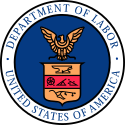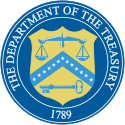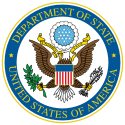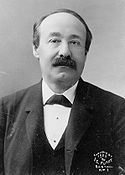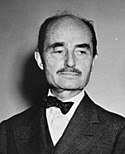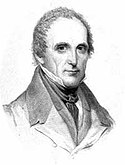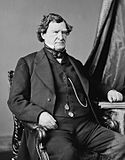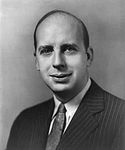United States Attorney General
| Attorney General of the United States – AG – | |
 | |
| Siegel des Justizministeriums der Vereinigten Staaten | |
 | |
| Standarte des Attorney General | |
| Ernennung durch | Präsident der Vereinigten Staaten |
| Schaffung des Amtes | 26. September 1789 |
| Anrede | Mr./Madam Attorney General |
| Stellvertreterin | United States Deputy Attorney General (DAG) |
| Erster Amtsinhaber | Edmund Randolph, United States Attorney General |
| Derzeitiger Amtsinhaber | Pam Bondi |
| Website | www.justice.gov |
Der United States Attorney General ist Mitglied des Kabinetts der Vereinigten Staaten und steht dem Justizministerium der Vereinigten Staaten vor, ohne den Titel „Secretary“ (Minister) zu tragen.
Zu seinen Aufgaben zählt die Beratung der Regierung in Justizfragen, die Kontrolle der Strafverfolgungsbehörden und die Vertretung der Vereinigten Staaten vor Gericht. Deshalb ist er nach dem deutschen System etwa Justizminister und Generalbundesanwalt in Personalunion. Mittlerweile verhandelt der Attorney General nur in Fällen von außergewöhnlicher Bedeutung selbst vor dem Obersten Gerichtshof; die meisten Vertretungen werden heute vom Solicitor General of the United States wahrgenommen.
1789 wurde das Amt des Attorney General vom Kongress der Vereinigten Staaten mit dem Zweck der Verfolgung und Vertretung in allen Rechtsstreiten vor dem Obersten Gerichtshof, in denen die Vereinigten Staaten Partei sind, geschaffen. Außerdem sollte er den Präsidenten und die Minister im Kabinett in allen Rechtsfragen beraten. Ein eigenes Justizministerium wurde erst 1870 zur Unterstützung des Attorney General geschaffen.
Liste der Attorneys General
Siehe auch
- United States Deputy Attorney General
- United States Associate Attorney General
- Solicitor General of the United States
- Attorney General (US-Bundesstaaten)
- Nannygate
- Kabinett der Vereinigten Staaten
- Justizministerium der Vereinigten Staaten
Literatur
- John J. Patrick, Richard M. Pious, Donald A. Ritchie: The Oxford Guide to the United States Government. Oxford University Press, New York 2001, ISBN 978-0-19-514273-0, S. 35f (= Attorney General of the United States).
Weblinks
- Biographien der Attorneys General (englisch)
Einzelnachweise
- ↑ Die Rechtmäßigkeit der Berufung, der Betrauung Whitakers mit der Russland-Sonderermittlung und der Nicht-Befangenheitserklärung Whitakers ist umstritten, siehe John E. Bies: Matthew Whitaker’s Appointment as Acting Attorney General: Three Lingering Questions. In: Lawfare, 8. November 2018.
- ↑ US Justizminister William Barr tritt zurück. Zeit online, 14. Dezember 2020, abgerufen am 15. Dezember 2020 (deutsch).
Auf dieser Seite verwendete Medien
Harlan Fiske Stone, Chief Justice of the United States. The left side of Stone's face was darkened by the uploader for more uniformity.
Official portrait of United States Attorney General Loretta Lynch
John Nelson, former United States Attorney General (1843-45). Also member of the U.S. House of Representatives (Whig-Maryland, 1841-43).
James C. McReynolds, United States Attorney General and Associate Justice of the United States Supreme Court
Portrait of Edmund Jennings Randolph by Casimir Gregory Stapko, after Flavius J. Fisher, after the original by an unidentified artist
United States Attorney General Alberto Gonzales - official Department of Justice photograph
Nathan Clifford. Library of Congress description: "Clifford, Judge Nathan (Supreme Court)"
John Macpherson Berrien, U.S. Attorney General 1829–1831, portrait.
Alexander Mitchell Palmer
Stanberry AttorGen
John Y. Mason, Secretary of the Navy, 26 March 1844 - 10 March 1845,
and 10 September 1846 - 7 March 1849Seal of the United States Department of Homeland Security. A graphically styled American eagle appears in a circular blue field. The eagle's outstretched wings break through an inner red ring into an outer white ring that contains a circular placement of the words "U.S. DEPARTMENT OF" in the top half and "HOMELAND SECURITY" in the bottom half. The outer white ring has a silvery gray border. As in The Great Seal, the eagle’s left claw holds an olive branch with 13 leaves and 13 seeds while the right claw grasps 13 arrows. Centered on the eagle's breast is a shield divided into three sections containing elements that represent the homeland "from sea to shining sea." The top element, a dark blue sky, contains 22 stars representing the original 22 agencies and bureaus that have come together to form the department. The left shield element contains white mountains behind a green plain underneath a light blue sky. The right shield element contains four wave shapes representing the oceans, lakes and waterways alternating light and dark blue separated by white lines.
Seal of the United States Department of Housing and Urban Development.
The seal was originally unveiled on November 10, 1966, and later defined in law (Federal Register 32FR366-67 and 24 CFR subtitle A, §11.1, both since removed as part of a streamlining of the federal code). The seal was defined as:
On a white background within a circle composed of the words, "U.S. Department of Housing and Urban Development," is an eagle and two stars. The six upper bars depicting the upper portion of the eagle's wings, the torso of the eagle, the star at the right of the eagle, and the words, "U.S. Department of Housing and Urban Development," are colored blue. The eight lower bars depicting the lower portion of the eagle's wings and the star at the left of the eagle are colored green."
The seal is a representative of high rise buildings simulating an eagle and giving emphasis to the "urban" in HUD's name. The eagle (shown abstractly) is a symbol of Federal authority. The use of green symbolizes open space, land, growth and prosperity. The blue in the Seal alludes to the quality of life and environment in America's cities.
More information here.Matthew Whitaker, United States Attorney
William Barr
Attorney General
William Pelham Barr was sworn in as Attorney General on February 14, 2019.William French Smith, U.S. Attorney General, 1981-1985
The seal of the United States Department of the Treasury.
The original seal dates from the Board of Treasury during the Articles of Confederation, and so predates the department (and Federal Government) itself. The current design is a slight simplification of the original, introduced in 1968.
The seal's arms depicts balancing scales (to represent justice), a key (the emblem of official authority) and a chevron with thirteen stars (to represent the original states).
For more information, see here.Reverdy Johnson. Library of Congress description: "Hon. Reverdy Johnson"; Library of Congress Prints and Photographs Division, Brady-Handy Photograph Collection; CALL NUMBER: LC-BH82- 29 B
Seal of the United States Department of Justice.
The origins of the seal are unknown; it was first used in the 19th century as the seal for the Office of the Attorney General (prior to the formation of the Department of Justice) but the exact date is unknown. Even the translation of the Latin motto is murky, a matter of debate between Latin scholars. The Department's currently accepted translation is who prosecutes on behalf of Lady Justice, referring to the Attorney General. The motto is an allusion to the wording of the writ in a qui tam action: qui tam pro domino rege quam pro se ipso sequitur ("he who sues on behalf of our lord the King as well as for himself." The current-day seal dates from 1934, when some (though not all) of the heraldic mistakes on the original were corrected. More information here.The seal of the United States Department of Health and Human Services. The symbol represents the American People sheltered in the wing of the American Eagle, suggesting the Department’s concern and responsibility for the welfare of the people. The colors are reflex blue and gold.
This seal is now just used for mainly legal purposes; the department has a separate logo which is used for its visual identity.
More information here and here.Seal of the United States Department of Education.
The seal was introduced on May 7, 1980, and is described in law as:More information here and 34 CFR Part 3.Standing upon a mound, an oak tree with black trunk and limbs and green foliage in front of a gold rising sun, issuing gold rays on a light blue disc, enclosed by a dark blue border with gold edges bearing the inscription "DEPARTMENT OF EDUCATION" above a star at either side of the words "UNITED STATES OF AMERICA" in smaller letters in the base; letters and stars in white.
Seal of the US Environmental Protection Agency (EPA).
Michael Mukasey, Attorney General of the United States.
Thomas Watt Gregory (* 6. November 1861 in Crawfordsville (Mississippi); † 26. Februar 1933 in New York City), US-amerikanischer Jurist, Politiker und Justizminister
Harry M. Daugherty, Attorney General of the United States.
Merrick Garland photograph was provided to press by the United States Court of Appeals for the District of Columbia Circuit in 2016 on occasion of Garland's nomination to the Supreme Court of the United States by US President Barack Obama. At the time Garland was chief judge of the United States Court of Appeals for the District of Columbia Circuit, having served as a federal judge on the court since 1997.
New Jersey politician John W. Griggs.
Seal of the United States Department of Transportation, introduced on 17 November 1980. The seal is described in 49 CFR 3.1 as 'A white abstract triskelion figure signifying motion appears within a circular blue field. The figure is symmetrical. The three branches of the figure curve outward in a counter-clockwise direction, each tapering almost to a point at the edge of the field. Surrounding the blue circle is a circular ring of letters. The upper half of the ring shows the words “Department of Transportation”. The lower half of the ring shows the words “United States of America”. The letters may be shown in either black or medium gray. The official seal of the Department is modified when embossed. It appears below in black and white.'
William Henry Harrison Miller
Official portrait of United States Attorney General Jeff Sessions
George Henry Williams, former Attorney General of the United States.
Homer Stille Cummings, Attorney General of the United States.
Benjamin_Civiletti
Autor/Urheber:
Unbekannter Fotograf
, Lizenz: PD-alt-100Benjamin H. Brewster (* 13. Oktober 1816; † 4. April 1888), US-amerikanischer Jurist, Politiker und Justizminister (Attorney General)
Janet Reno, *1938-07-21, 78th Attorney General of the United States (1993–2001)
William Bart Saxbe
TITLE: Hon. Charles Devens of Mass. Atty Gen. Hayes Cabinet
CREATED/PUBLISHED: [between 1865 and 1880]
http://hdl.loc.gov/loc.pnp/cwpbh.04704
Robert Kennedy appearing before Platform Committee
Seal of the United States Department of the Interior.
The seal consists of a male bison with the head and body in a left position, standing on a prairie, with mountains and a rising sun in the background, enclosed within two concentric circles, having the words "U.S. Department of the Interior" and the date "March 3, 1849" (when Congress created the department) inscribed in the top and bottom arcs within these circles. See here for more information.
The bison seal dates from 1917, when it was used as the emblem on the initial department flag and thereafter replaced the old version of the seal, which used a federal eagle. The eagle was reinstated for a few years in the 1920s, and a different seal was used from 1968-69, but on both occasions the bison seal was reinstated. For more information see this chapter in The Department of Everything Else: Highlights of Interior History.William Henry Moody (1853-1917), was an American politician and jurist, United States Secretary of the Navy (1902-1904), Attorney General of the United States (1904-1906), Associate Justice of the Supreme Court of the United States (1906-1910).
The creation of the new Department of Veterans Affairs in 1989 required a new official seal to represent VA. In November 1988, after the law establishing VA as a cabinet department was signed, VA initiated a competition among employees for a seal design that would give the new department a "new look." The winner of that competition, and creator of today's VA seal was David E. Gregory, a medical media production specialist at the Indianapolis VA Medical Center. These are the key elements of the seal, as he described them:
- The eagle represents the United States.
- The circle of five stars above the eagle represents the Army, Navy, Air Force, Marines and Coast Guard.
- The two flags in the eagle's talons represent the span of America's history from 13 colonies to the present 50 states.
- The flags are bound by a golden cord symbolic of those Americans who have fallen in service to their country.
- The eagle holds the cord to perpetuate the memory of those veterans who have fallen and sacrificed for the nation.
James P. McGranery (* 1895; † 1962), United States politician
The photo is credited to the LBJ library which would put it under NARA and in the public domain.
Amos T. Akerman. Library of Congress description: "Ackerman, Hon. Ames, Atty. Gen."
William M. Evarts. Library of Congress description: "Evarts, Hon. Wm of N.Y. Secty of State, Hays Cab."
Francis Biddle
Wayne MacVeagh. Library of Congress description: "MacVeagh, Hon. Wayne Atty-General".
Augustus Hill Garland. Library of Congress description: "Garland, Hon. A.H. Attny General"
Seal of the Vice President of the United States. The blazon is defined in Executive Order 11884 as:
The design is the same as the Seal of the President of the United States, except that there is no ring of stars, the clouds are gray (instead of proper), the stars are gray (instead of argent), the scroll is gray (instead of white), the arrows are gray (instead of proper), and the background colors and inscription (obviously) differ.The Coat of Arms of the Vice President of the United States shall be of the following design:
SHIELD: Paleways of thirteen pieces argent and gules, a chief azure; upon the breast of an American eagle displayed holding in his dexter talon an olive branch proper and in his sinister a bundle of thirteen arrows gray, and in his beak a gray scroll inscribed "E PLURIBUS UNUM" sable.
CREST: Behind and above the eagle a radiating glory or, on which appears an arc of thirteen cloud puffs gray, and a constellation of thirteen mullets gray.
The Seal of the Vice President of the United States shall consist of the Coat of Arms encircled by the words "Vice President of the United States."
Seal of the United States Department of Commerce.
The seal was approved on April 4, 1913 and is derived from the seal of the defunct United States Department of Commerce and Labor. It is composed of the arms (Per fesse azure and or, a ship in full sail on waves of the sea, in chief proper; and in base a lighthouse illumined proper), and crest ("The American Eagle displayed"). Around the arms, between two concentric circles, are the words "Department of Commerce" and "United States of America".
The official symbolism has been modified as the functions of the department have changed. As of 2007: the ship is a symbol of commerce; the blue denotes uprightness and constancy; the lighthouse is a well-known symbol representing guidance from the darkness which is translated to commercial enlightenment; and the gold denotes purity. The crest is the American bald eagle denoting the national scope of the Department's activities.
Full description at CFR Title 15 Part 1, Attorney General 1949-1952
United States Attorney General George W. Wickersham.
Joseph McKenna, Associate Justice, Supreme Court, full-length portrait, seated, facing right
William D. Mitchell, 18th Solicitor General of the United States and 54th United States Attorney General
Attorney General John N. Mitchell
Jeremiah S. Black.
Autor/Urheber: unknown, Lizenz:
Edwin Meese III (*1931-12-02), Former U.S. Attorney General at Reagan Stamp Dedication (2005-02-10)
Seal of the United States Department of Agriculture.
The USDA seal was created in 1895. It was adapted for use as a general identifier in 1980, but those usages were replaced with the USDA Logo in 1996. The seal has been withdrawn from use as a departmental identifier, though it is still used on legal materials and other internal uses.
The seal is defined as:Two and three-eights inches in diameter (azure), a shock of corn (or), upon a base (vert) an American plough proper. All within a double annulet (argent), outer roped, inner beaded, charged with the inscription: UNITED STATES DEPARTMENT OF AGRICULTURE, and at the base, a scroll bearing the legend: "1862.AGRICULTURE IS THE FOUNDATION OF MANUFACTURE AND COMMERCE. 1889." (or). A diapered background of 44 stars (argent) for the States of the Union.
The dates on the scroll represent the year the Department was founded by act of Congress (1862), and the year the Department was made an Executive Office headed by a Secretary of cabinet rank (1889). The 44 stars represent the states in the Union in 1889.
See here and here for more information.Seal of the United States Department of Defense from 2001 to 2022.
US Attorney General Herbert Brownell
Griffin Boyette Bell – 77nd United States Attorney General
Official photo of Monty Wilkinson, Deputy Assistant Attorney General for Human Resources at the U.S. Department of Justice.
Seal of the United States Office of Management and Budget. It is described in Executive Order 11600 as:
On a blue disc, the Arms of the United States proper above a curved gold scroll inscribed "OFFICE OF MANAGEMENT AND BUDGET", in black raised letters, all within a white border edged gold and inscribed "EXECUTIVE OFFICE OF THE PRESIDENT OF THE UNITED STATES", in blue raised letters. Dark blue suggested by the Seal of the President denotes the direct organizational link with the Presidential office. The arms of the United States refer to the entire Nation and represent the Office's involvement in the organizational and technological processes necessary to assist the President in his role as Chief Executive of the United States.
Edwards Pierrepont, former Attorney General of the United States.
The official flag of the United States Attorney General (AG).































































































